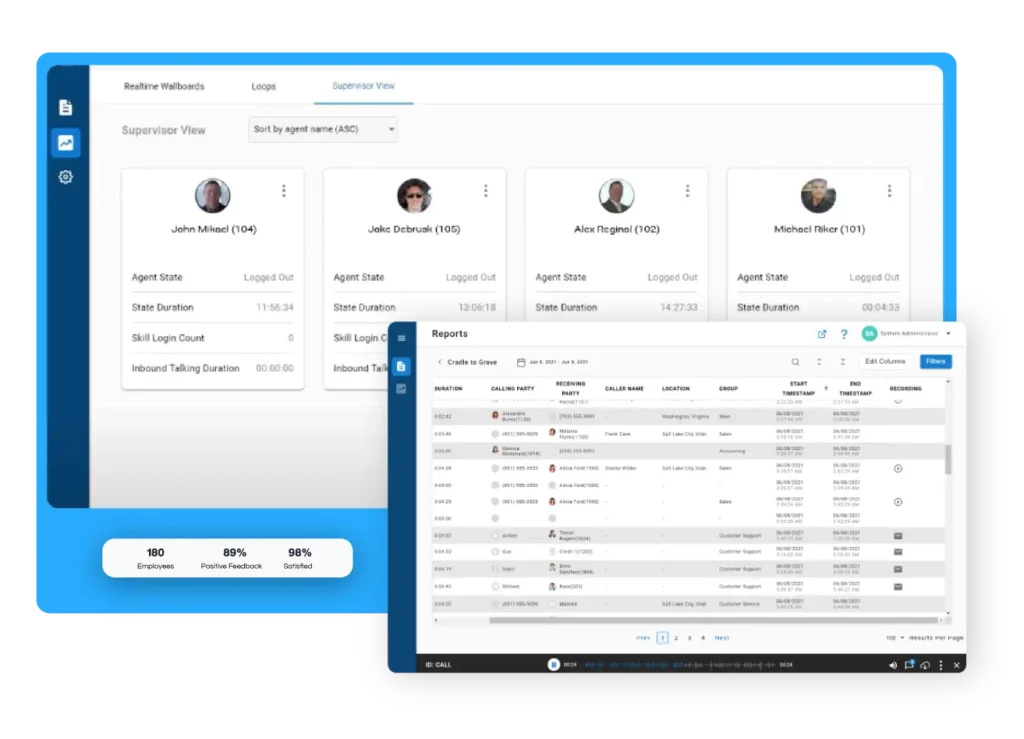Call center technology has evolved far beyond phones and headsets. Today’s contact centers rely on an ecosystem of tools designed to streamline workflows, personalize customer interactions, and drive smarter decisions in real time. With the right technology in place, teams can deliver faster service, reduce manual tasks, and improve the overall customer experience.
In this blog, we’ll explore the different types of call center technology available today, highlight the key benefits they offer, and examine emerging trends shaping the future of contact centers.
Key Takeaways
- Modern call center technology connects voice, digital channels, automation, and real-time data to create a more efficient and customer-focused service environment.
- Having the right technology in place improves customer satisfaction, boosts operational efficiency, lowers costs, and turns data into smarter business decisions.
- The key trends shaping the future of call center technology include the shift to cloud-based platforms, the rise of AI-driven tools, and the growing demand for omnichannel communication.
What is Call Center Technology?
Call center technology is a collection of tools, systems, and platforms that support customer service teams in managing interactions efficiently and effectively. This includes everything from phone systems and interactive voice response (IVR) to call routing, reporting dashboards, and omnichannel communication tools.
As customer expectations have grown, so has the technology. What was once a phone-only operation has transformed into a fully connected contact center that supports voice, chat, email, and more to deliver a seamless customer experience.
Benefits of Contact Center Technology
Modern contact center tools offer:
- Improved Efficiency: Automates repetitive tasks, like call routing and data entry, so agents can focus on higher-value conversations.
- Faster Resolution Times: Equips teams with quick access to customer data and real-time insights, leading to quicker solutions.
- Stronger Customer Relationships: Supports personalized, consistent service across channels that helps build trust and loyalty.
- Data-Driven Decision Making: Provides detailed analytics that enable managers to track performance, identify trends, and refine strategies.
- Scalability: Enables you to grow your team or support increased volume without compromising service quality.
Key Components of Modern Call Center Technology
Running a high-performing contact center takes more than just having the right people—it also requires the right tools. Modern call center technology is designed to streamline operations, empower agents, and deliver exceptional customer experiences across every touchpoint. Although every system is different, they typically include:
A. Voice over Internet Protocol (VoIP)
VoIP is the foundation for most modern contact centers. It replaces traditional phone lines by converting voice into digital packets and transmitting them over the internet. This shift offers greater flexibility for remote work, simplifies infrastructure, and reduces telecom costs. VoIP also supports features like call forwarding, virtual extensions, and device mobility, helping teams stay connected no matter where they work.
B. Automatic Call Distributor (ACD)
An ACD system routes inbound calls to the most appropriate agent based on pre-set rules like skill level, department, or availability. This improves efficiency by matching each customer with the right resource the first time. ACD systems help minimize hold times and avoid unnecessary transfers, which has a direct impact on satisfaction scores. They’re also essential for balancing workloads across teams and optimizing service levels during peak hours.
C. Interactive Voice Response (IVR)
IVR technology allows customers to interact with an automated menu using either voice commands or touch-tone input. It handles routine questions, routes complex issues, and helps reduce wait times. It’s a critical first step in the customer journey that helps callers self-serve or reach the right agent quickly. A well-designed IVR improves customer satisfaction and agent productivity.
D. Computer Telephony Integration (CTI)
CTI connects the phone system with your customer database and support tools. It automatically pulls up customer information on the agent’s screen as the call comes in, giving teams a head start on the conversation. CTI eliminates the need to ask repetitive questions and speeds up issue resolution. With CTI in place, agents can focus more on helping the customer and less on toggling between systems.
E. Quality Management (QM) & Call Recording
Quality Management and call recording tools give supervisors the insight they need to coach agents and maintain service standards. Every conversation becomes a learning opportunity when calls are monitored and evaluated against clear criteria. Recordings also help protect your team by providing a reliable record of customer interactions. Together, these tools support ongoing improvement and ensure a consistent customer experience.
F. Customer Relationship Management (CRM) Integration
CRM integration connects contact center systems with your customer data platform, creating a more complete picture of every interaction. When agents can see past tickets, call history, and customer notes in real time, they can deliver more relevant, personalized support. It also reduces the need to switch between platforms or ask the same questions over again. With CRM integration, agents come to every conversation prepared, confident, and ready to solve problems quickly.
G. Call Queuing
Call queuing technology holds incoming calls in a virtual line when all agents are busy. Instead of a frustrating busy signal, callers receive estimated wait times, customized hold messages, or the option to request a callback. These features help reduce call abandonment rates and set clear expectations from the start. It’s a simple but powerful way to improve the waiting experience and keep customers engaged until help is available.
H. Real-time Call Monitoring
Real-time call monitoring allows supervisors to listen in on active calls as they happen. They can silently monitor, whisper advice to the agent, or join the call directly to assist with complex situations. This gives leaders a proactive way to support their teams and ensure that service quality stays high. It’s also a valuable training tool.
I. Reporting and Analytics
Contact centers generate a constant stream of data, and reporting tools help make sense of it all. Metrics like average handle time, first call resolution, and call abandonment offer a detailed look at performance trends. With the right analytics in place, teams can identify gaps, uncover customer pain points, and improve decision-making. These insights support day-to-day management and help shape long-term strategy.
Call Center Technology Trends to Look Out For
As customer expectations evolve and technology continues to advance, contact centers are moving quickly to stay ahead. New tools and smarter systems are making interactions more efficient, more personalized, and easier to manage across every channel.
Artificial Intelligence (AI): Chatbots, sentiment analysis, predictive analytics.
AI is making a major impact on how contact centers manage customer interactions. Tools like chatbots and virtual assistants handle routine questions automatically, freeing up agents to focus on more complex or high-value calls. Predictive analytics enables teams to forecast call volumes, identify customer needs in advance, and route conversations more effectively. AI is also being used for real-time sentiment analysis, providing agents and supervisors with instant insight into how a customer is feeling, allowing them to adjust their tone or approach accordingly. Together, these innovations help contact centers work faster, smarter, and more in tune with customer expectations.
Cloud-Based Contact Centers
More organizations are shifting away from on-premise systems and moving to cloud-based contact center platforms. These solutions offer greater flexibility by allowing teams to operate from anywhere while maintaining full access to communication tools, reporting, and call management systems. Cloud-based systems are also easier to scale, whether you’re adding new agents, expanding to different regions, or rolling out new features. The ability to launch and manage virtual call centers worldwide has opened up new opportunities for both efficiency and cost savings.
Omnichannel Communication Systems
Customers expect to engage with businesses through the channel that’s most convenient for them, such as voice, chat, email, social, or even SMS. Omnichannel systems bring all of these communication methods into a single, unified platform. This ensures that customer conversations stay consistent and seamless, even when switching between channels or interacting with multiple agents. It also helps your team deliver faster service and maintain context without starting from scratch.
Empowering Your CX with Call Center Technology
Modern call center technology gives your team the tools to deliver faster service, improve efficiency, and create better customer experiences. As trends like AI, cloud platforms, and omnichannel systems continue to shape the industry, having the right technology in place helps you stay ahead and adapt with confidence.
Xima brings these capabilities together in one powerful, easy-to-use platform. If you’re ready to simplify operations, improve performance, and support your team with technology that actually works, we’re here to help. Schedule a demo today to see how we can help your contact center grow.
FAQs about Contact Center Technology
Cloud-based solutions can be just as secure, if not more so, than on-premise systems when implemented with proper safeguards. Leading cloud platforms follow strict security protocols, including data encryption, regular updates, and access controls. Cloud systems also enable faster responses to threats and easier disaster recovery.
A call center typically focuses on voice-only communication, while a contact center handles customer interactions across multiple channels like phone, email, chat, and social media. Contact centers offer a more unified and flexible experience that meets customers where they are. The shift to contact centers reflects the growing demand for seamless, personalized service across all touchpoints.
The right tools help agents resolve issues faster, personalize conversations, and reduce wait times. Features like intelligent call routing, CRM integration, and real-time monitoring make it easier to deliver consistent, high-quality service. Customers notice when their experience is smooth, efficient, and tailored to their needs. That kind of service builds trust and keeps people coming back.
AI helps contact centers by automating repetitive tasks, analyzing customer sentiment, and offering real-time insights to agents and supervisors. Tools like chatbots, virtual assistants, and predictive analytics help reduce wait times and improve first-call resolution. With AI working in the background, teams can focus more on delivering a great experience.
AI is designed to enhance contact centers, not replace them. While automation handles routine inquiries, human agents remain essential for complex, emotional, or high-stakes interactions. AI supports teams by providing context, surfacing insights, and freeing up time for more meaningful conversations. The most successful contact centers use AI to empower their people, not to eliminate them.



